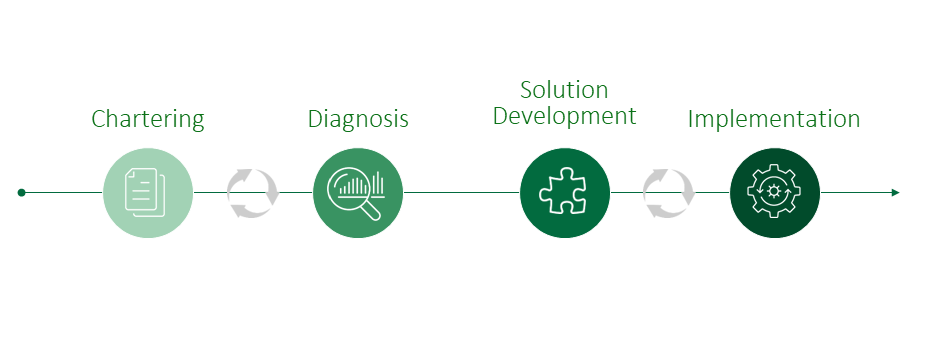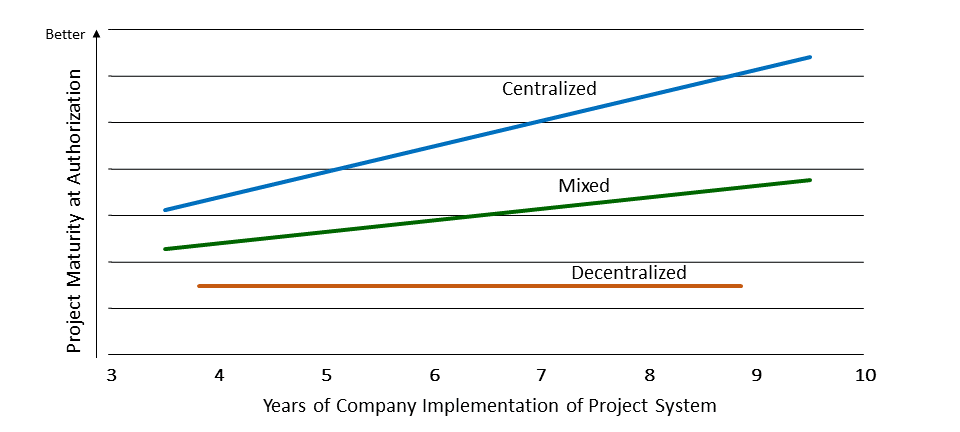The Problem:
As outlined in part one of this case study, IPA was enlisted to help a mid-size global specialties company with unreliable project outcomes. To address this problem, IPA first assessed the company’s current state to diagnose the root of the problem.
In Part 2, we explore the next steps: solution development and implementation.

The Next Steps: Solution Development and Implementation
After aligning on the current state, IPA worked with the client to develop solutions and a plan to implement those solutions. Although this sounds easy enough, it is not. We found that multiple areas needed improvement. In addition, while those improvement efforts are underway, current company project work is ongoing. Thus, any improvement effort must balance the company’s current project needs with the identified system improvement work.
The solution development work started with creating a vision of the company’s desired future state. Without a destination, it is not possible to map out the steps needed to get there. The future state description details out the behaviors, practices, and performance aligned with project delivery as a core competency for the company.
IPA then worked with the client to identify the solution levers to reach the future state. These levers range from company-wide communications to building a new centralized project organization to installing process procedures and templates. We grouped the levers into six main categories, as shown below.
Transformation Levers to Achieve the Future State

After targeting a future state and outlining the steps to get there comes the hard work of deciding what to do and when. As shown below, improving a company process takes time. In fact, it can take 5 to 7 years to see the efforts made fully pay off.
Project System Implementation Progress

Because it is not feasible to implement all the targeted areas of improvement at the same time while completing ongoing work, we narrowed in on the first few levers to “pull” for the biggest impact. We discuss two of these levers below.
Stakeholder Management and Communication
The importance of this lever cannot be understated: it is critical for all the other levers to work. Without understanding and buy-in from key stakeholders, the improvement effort will fail. The scope of this lever includes a workshop with the client to identify stakeholder management and communication needs, including:
- Key stakeholders and their potential influence on this effort
- Target audiences for the identified key messages across the entire organization
- How the key messages will be delivered, how often, and what supporting materials are required
- What information is needed from outside the capital projects group
The results are documented in a transformation stakeholder management and communication plan that leverages the design, planning, and implementation work contained in other levers and IPA’s project systems research and experience of transformation efforts with other companies.
The communication lever support efforts in implementing other levers, including positioning of capital projects, successfully deploying the sponsor role, and governance. While these efforts are being implemented, it is important to be able to measure progress toward that future state. Managing expectations is key to this effort and communication across the company is needed to do this.
Developing Strategic Project Resources
This lever focuses on deploying company resources to run projects where they add the most value. It includes selecting the resources with the right skills at the right location for the right project drivers or scope. This lever includes not only hiring new resources to fill the needed slots but also developing roles and responsibilities (R&Rs) for the new and existing resources.
While working to implement the vision of the new organization, the immediate needs of strategic projects can be addressed.
Workshops using IPA’s project risk and readiness frameworks that assess clarity of objectives, team development, Front-End Loading, controls, etc. provide an objective view of each strategic project’s current state to:
- Gain alignment with the project leadership on their project’s status and risks, and make practical recommendations for the way the projects are managed in current or future project phases to reduce risk and improve the chance of project success
- Describe the range of IPA support opportunities (reviews, workshops, tools) that we think would be most beneficial through the project lifecycle, and explain the value of these to the project
- Develop a tailored action plan for support to each project
These workshops provide value in their own right because they provide an opportunity for the project leaders to take advantage of IPA’s deep knowledge of project risks, measures of readiness, and industry Best Practices to explore how these can be applied practically in their projects.
A secondary objective of this effort is to leverage this support to individual projects to further develop and improve the company’s project system, converting project-specific content into generally applicable system content where possible. For example, BEAM workshops will improve clarity of objectives and trade-offs for these particular projects—critical for project success—but will also help demonstrate the target roles and behaviors from sponsors and other stakeholders that we seek to develop across the project portfolio under other transformation levers.
Achieving the Targeted Future State
Progress toward the company’s desired future state is an ongoing effort. As noted, it takes a substantial amount of time to reach this goal. The levers developed and sequenced allow the company to make forward progress while continuing its day-to-day business.